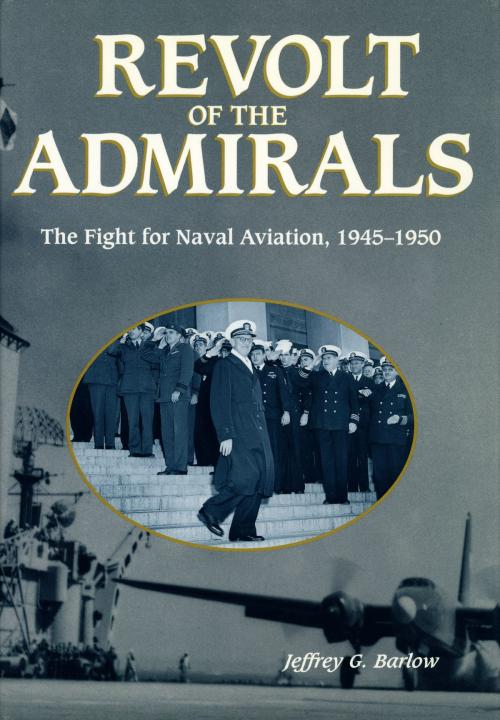Revolt of the Admirals: The Fight for Naval Aviation, 1945-1950
Nonfiction, History, Military, Aviation, Naval| Author: | Jeffrey G. Barlow | ISBN: | 9781622800070 |
| Publisher: | Historical Studies | Publication: | November 1, 2012 |
| Imprint: | Language: | English |
| Author: | Jeffrey G. Barlow |
| ISBN: | 9781622800070 |
| Publisher: | Historical Studies |
| Publication: | November 1, 2012 |
| Imprint: | |
| Language: | English |
Chronicles in compelling detail the historic showdown between the U.S. Air Force and the Navy over the role of carrier aviation in the national security framework of the United States.
The National Security Act of 1947, intended to unify the separate armed services under a single Defense Secretary, failed to settle the deeper issue that divided them, the debate over roles and missions. One symptom of this conflict was a showdown between the Air Force and the Navy over the role of carrier aviation in the national security framework of the United States.
From the early days of aviation, Army and Navy aviators had approached their roles very differently. Army air doctrine centered on strategic bombing, while Navy doctrine focused on carrier air power as an increasingly important element of the fleet’s offensive striking power. In the postwar era of demobilization, these differences were exacerbated as each service fought for its share of a decreasing defense budget. Louis A. Johnson’s appointment as Secretary of Defense in late March 1949 added to the Air Force-Navy friction. While Johnson allowed procurement of B-36s for the Air Force’s strategic bombing program to be greatly accelerated, he cancelled development of the first flush-deck supercarrier, which would have enabled the Navy to operate long-range attack aircraft capable of carrying atomic weapons. This rejection fueled the Navy’s fear that naval aviation was to have a diminishing role in the new atomic age and provided the final impetus for a clash between the Air Force and the Navy.
The conflict came to a head when an anonymous document was delivered to members of Congress in May 1949, alleging improprieties in the Air Force procurement of the B—36 bomber. Although later found to be baseless, these charges inspired two sets of congressional hearings: the first on the B-36 bomber program itself, and the second on the issue of unification and strategy. During the latter hearings, high-ranking naval officers voiced their opinions that naval aviation was being denigrated by a Defense Secretary enamored with the possibilities of strategic bombing and scornful of the Navy’s contribution to such a mission. The press soon termed their vehement testimony in support of naval aviation the “revolt of the admirals.”
Chronicles in compelling detail the historic showdown between the U.S. Air Force and the Navy over the role of carrier aviation in the national security framework of the United States.
The National Security Act of 1947, intended to unify the separate armed services under a single Defense Secretary, failed to settle the deeper issue that divided them, the debate over roles and missions. One symptom of this conflict was a showdown between the Air Force and the Navy over the role of carrier aviation in the national security framework of the United States.
From the early days of aviation, Army and Navy aviators had approached their roles very differently. Army air doctrine centered on strategic bombing, while Navy doctrine focused on carrier air power as an increasingly important element of the fleet’s offensive striking power. In the postwar era of demobilization, these differences were exacerbated as each service fought for its share of a decreasing defense budget. Louis A. Johnson’s appointment as Secretary of Defense in late March 1949 added to the Air Force-Navy friction. While Johnson allowed procurement of B-36s for the Air Force’s strategic bombing program to be greatly accelerated, he cancelled development of the first flush-deck supercarrier, which would have enabled the Navy to operate long-range attack aircraft capable of carrying atomic weapons. This rejection fueled the Navy’s fear that naval aviation was to have a diminishing role in the new atomic age and provided the final impetus for a clash between the Air Force and the Navy.
The conflict came to a head when an anonymous document was delivered to members of Congress in May 1949, alleging improprieties in the Air Force procurement of the B—36 bomber. Although later found to be baseless, these charges inspired two sets of congressional hearings: the first on the B-36 bomber program itself, and the second on the issue of unification and strategy. During the latter hearings, high-ranking naval officers voiced their opinions that naval aviation was being denigrated by a Defense Secretary enamored with the possibilities of strategic bombing and scornful of the Navy’s contribution to such a mission. The press soon termed their vehement testimony in support of naval aviation the “revolt of the admirals.”















